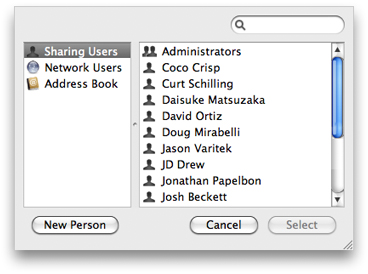Using the Identity Picker
Most applications that use identities require someone to select users to be added to an access control list (ACL). Enter the Identity Picker. The Identity Picker is managed by the CBIdentityPicker class in the Collaboration framework. It allows users an easy interface for not only selecting identities but also for promoting entries in the Address Book to sharing users. As an application developer, no extra work is needed to allow users to create identities; this capability comes free from invoking the Identity Picker. This chapter describes how to customize the Identity Picker for your application and how to invoke the correct implementation of the Identity Picker.

Creating and Customizing the Identity Picker
For every Identity Picker your application requires, you should create a separate instance of the CBIdentityPicker class.
The ability of the Identity Picker to select multiple entries at once is a customizable feature. By default, the Identity Picker does not allow multiple selections. To change the default setting, call the setAllowsMultipleSelection: method and pass the value YES. See Listing 2-1 for an example of how to use these methods.
Listing 2-1 Customizing an CBIdentityPicker instance
// Instantiate an ABIdentityPicker object. |
CBIdentityPicker *picker = [[CBIdentityPicker alloc] init]; |
// Allow the Identity Picker to select multiple entries. |
[picker setAllowsMultipleSelection:YES]; |
Invoking the Identity Picker Sheet
The beginSheetModalForWindow:modalDelegate:didEndSelector:contextInfo: method invokes the Identity Picker as a sheet.
The first argument is the window in which the sheet should open. In most cases, this is [sender window]. The modalDelegate argument is the delegate object. The didEndSelector argument is the method that will be called when the user selects identities and chooses either the OK or Cancel button. It should be a method that contains three arguments of its own: a CBIdentityPicker object, a return code, and a context. Finally, the contextInfo argument is any object you want sent to the delegate method.
Listing 2-2 Invoking the Identity Picker sheet
- (IBAction)plusButton:(id)sender |
{ |
[picker beginSheetModalForWindow:[sender window] |
modalDelegate:self |
didEndSelector:@selector(identityPickerDidEnd:returnCode:contextInfo:) |
contextInfo:nil]; |
} |
When the user closes the Identity Picker, the delegate method (identityPickerDidEnd:identities:contextInfo:) is called. This method passes the selected identities as an array of CBIdentity objects and the context defined by the method beginSheetModalForWindow:modalDelegate:didEndSelector:contextInfo:. See Listing 2-3.
Listing 2-3 Retrieving identities from the Identity Picker
- (void)identityPickerDidEnd:(CBIdentityPicker *)identityPickerController returnCode:(NSInteger)returnCode contextInfo:(void *)contextInfo |
{ |
NSEnumerator *enumerator = [[identityPickerController identities] objectEnumerator]; |
CBIdentity *nextIdentity; |
while (nextIdentity = [enumerator nextObject]) { |
//Do something interesting with the nextIdentity object |
} |
} |
Invoking the Identity Picker Modal Dialog
To use the Identity Picker modal dialog, call the method runModal. This method invokes the modal identity picker. If the user selects the OK button in the Identity Picker window, you can return the selected identities with the identities method. The identities method returns an array of CBIdentity objects. See Listing 2-4.
Listing 2-4 Invoking the modal Identity Picker
- (IBAction)plusButton:(id)sender |
{ |
NSArray *identities; |
NSEnumerator *enumerator; |
CBIdentity *nextIdentity; |
if ([picker runModal] == NSOKButton) { |
identities = [picker identities]; |
enumerator = [identities objectEnumerator]; |
// Enumerate over the returned identities |
while ((nextIdentity = [enumerator nextObject])) { |
// Do something interesting with the identity object |
} |
} |
} |
Copyright © 2012 Apple Inc. All Rights Reserved. Terms of Use | Privacy Policy | Updated: 2012-02-16